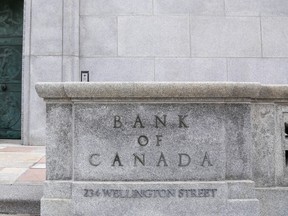Kevin Carmichael’s take on the week in economics
Article content
Financial Post columnist Kevin Carmichael, editor of the FP Economy newsletter, unpacks the week in economics.
Housing fatigue
“You are starting to see some early signs of slowing in the housing market. We are expecting supply to improve and demand to slow down. We are expecting the housing market to come into better balance. It is going to take some time. It is something we are watching closely.”
— Tiff Macklem; Senate testimony; June 16, 2021.
Jonathan Gitlin, chief executive of RioCan Real Estate Investment Trust, told Larysa Harapyn on the Down to Business podcast recently that his growth strategy included condominiums. That might have struck some listeners as odd; Gitlin is in the business of satisfying demand and the pandemic has put a premium on space, not the shoeboxes that real-estate developers have been stacking in cities such as Toronto and Vancouver for the past decade or so. Intense demand for single and semi-detached homes is one of the main reasons housing prices spiked in the middle of a recession. “Canadians want more space,” Bank of Canada Governor Tiff Macklem told the Senate banking committee on June 16.
Advertisement
This advertisement has not loaded yet, but your article continues below.
Article content
Canadians might want more space, but that doesn’t mean they necessarily need it. There was evidence last week that Canada’s latest bout of housing mania might have peaked, as the current price of a backyard and/or a home office clashes with the reality of what people are willing and/or able to pay.
The Canadian Real Estate Association reported on June 15 that monthly sales of existing homes dropped 7.4 per cent in May, following an 11-per-cent decline in April. “More and more, there is anecdotal evidence of offer fatigue and frustration among buyers, and the urgency to lock down a place to ride out COVID would also be expected to fade at this point given where we are with the pandemic,” Cliff Stevenson, the association’s chair, said in a press release.
The average price was about $688,000, a little lower than in April, but much higher than in 2019, when the average price hovered around $500,000. Incomes haven’t increased that much, so it’s possible the market overshot this spring and is now settling at a new, albeit higher, plateau. The pre-pandemic trend for cheaper condominiums in bigger cities could be reasserting itself. Canada Mortgage and Housing Corp. said on June 15 that builders started work on single-family homes at a rate that would yield about 64,000 units in communities with populations greater than 10,000 people in May, an 18-per-cent drop from the previous month and the slowest annualized rate since December. At the same time, starts on all other types of housing increased 11 per cent to about 191,000, leaving the annual rate of total housing starts slightly faster than April, at about 255,000.
Advertisement
This advertisement has not loaded yet, but your article continues below.
Article content
Bottom line: builders such as RioCan aren’t betting on an exodus to the suburbs. The calculation could be that while the pandemic will be life-altering, it might not be life-changing. For Canadians, who seem bent on owning real-estate no matter what, the calculation could be as simple as this: if they are going to be house poor no matter where they go, they might as well settle in a big city, where they will at least be able to find something to do.

Discover Canada’s most overvalued housing markets.
Find out where Canada finished in Bloomberg’s “Bubble Ranking.”
Bonus read: Even Elon Musk thinks the housing market is insane.
Dollar drop
“We are good at many services. There is an opportunity for a strong rebound. If the Canadian dollar were to go higher, it could diminish this opportunity, so it’s something that we will be watching closely.”
— Tiff Macklem; Senate testimony; June 16, 2021.
The Canadian dollar started last week at about 82 U.S. cents. It ended the week at about 80 cents. What happened? The Federal Reserve delivered global traders a wake-up call, prompting a repricing of just about everything, including currencies.
Fed Chair Jerome Powell gathered America’s central bankers on June 15 and 16 in Washington. Wall Street wasn’t expecting much, but when policy-makers got to talking, they realized that they probably will need to accelerate their timetable for raising interest rates in order to stay ahead of inflation. The most recent reading of the U.S. Consumer Price Index (CPI) came in at five per cent, too hot even for the Fed, which had indicated that it was prepared to tolerate a faster rate of price increases if that’s what it took to get employment back to pre-crisis levels. Some investors decided that meant the Fed was asleep at the switch when it came to inflation. Apparently not. The majority of the members of the central bank’s policy committee now expect at least two interest-rate increases in 2023, whereas earlier this spring, most saw no significant changes coming until 2024.
Advertisement
This advertisement has not loaded yet, but your article continues below.
Article content
The Fed’s revised outlook also took some of the heat out of commodity prices, as traders recalculated forecasts for global economic growth with higher interest rates. Commodities had been putting upward pressure on Canada’s currency this year, so the reversal clipped the loonie’s ascent, as buyers suddenly needed fewer Canadian dollars to buy B.C. lumber, Alberta oil, Prairie grain, northern minerals, and Atlantic seafood.
But the realignment of interest-rate paths in Canada and the U.S. also explains the Canadian dollar’s drop. The Bank of Canada had already said that it would start considering an interest-rate increase in the second half of 2022 to keep inflation in check, making Canada an attractive option for bond investors in search of higher yields. It now looks like the Fed won’t be so far behind its Canadian counterpart, which should keep the loonie from flying any higher.

LEARN MORE ABOUT THE “POWELL PIVOT”
Low expectations
“There are still far too many Canadians unemployed. That is putting sustained downward pressure on inflation. To sustainably achieve our inflation target, we have to further advance this recovery and that’s why we are continuing, although at a lower level.”
— Tiff Macklem; Senate testimony; June 16, 2021
Canada’s CPI surged by the most in a decade in May, jumping 3.6 per cent, well outside the Bank of Canada’s comfort zone. That was nothing like what happened in the U.S., where the annual rate of price increases accelerated to five per cent. Still, the figure will have caused a certain amount of pause at the Bank of Canada, whose only official job is to keep the CPI advancing at an annual pace of about two per cent. For now, Governor Tiff Macklem is way off target.
Advertisement
This advertisement has not loaded yet, but your article continues below.
Article content
Macklem insists the current inflation burst is temporary. He told the Senate banking committee the current acceleration is “largely” the result of “base-year effects.” The CPI dropped to unusually low levels a year ago, so the numbers look unusually high now because they are being compared with a period of disinflation. There still are more than 500,000 fewer people working today then there were before the pandemic, suggesting the economy remains depressed below the surface. “These base effects will fade going forward, and the Governing Council expects that as that happens, the ongoing excess supply in the economy will pull inflation back down,” Macklem said.

Canada in top three frothiest housing markets flashing warnings not seen since the 2008 financial crisis

Fed holds rates at zero, projects two hikes by the end of 2023

Factors in Canada’s frothy real-estate market pushed inflation up in May
That’s probably true. Some economists compare the CPI with its level two years ago to get a rough idea of what the trend looks like without all the noise created by the pandemic. When you do that, current levels of headline inflation don’t look terribly unusual, although the rate is creeping higher. But that won’t matter if the general public decides that hyper-inflation is setting in. There’s a psychological side to inflation, as consumer and investor expectations of where prices are headed will bolster the underlying forces. Bond prices suggest that investors mostly believe the Bank of Canada’s story, but households might be less convinced. A new study by the Angus Reid Institute shows that nine in 10 Canadians think groceries, gasoline, and housing have become more expensive.
Advertisement
This advertisement has not loaded yet, but your article continues below.
Article content
Recency bias is at work there, as consumers tend to associate overall inflation with the items they purchase most often. Still, if individuals decide that life has become more expensive, they will start demanding higher compensation to make up for it. That’s when inflationary spirals really take off. Macklem’s most important job over the next few months will be that of a soothsayer.

CAN WE STAND THE HEAT?
• Email: kcarmichael@postmedia.com | Twitter: CarmichaelKevin
_____________________________________________________________
If you liked this story, sign up for more in the FP Economy newsletter.
_____________________________________________________________
Advertisement
This advertisement has not loaded yet, but your article continues below.
Postmortem: Housing fatigue | Financial Post
2021-06-21 09:00:09






